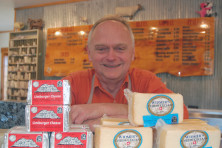It Melts in Your Mouth: Great Cheese & Conversation
- Share
- Tweet
- Pin
- Share

Felix Thalhammer of Capri Organic explains the benefits of using raw milk to make cheese. Thalhammer was the featured artisan cheesemaker at the Savory Spoon Cooking School on Aug. 9. Photo by Brittany Jordt.
I have always been a cheese lover and am extremely proud to be a native of the great dairy state: Wisconsin. On August 9, Felix Thalhammer of Capri Organic cheese in Blue River, Wi., drove up north to Ellison Bay just in time to greet a full class of passionate cheese mongers, including me.
Originally from Switzerland, Thalhammer became interested in cheese making when his son was born with a severe dairy allergy. To provide an alternative to cow milk, the family bought goats. They purchased a good many goats and found themselves with more milk than they could drink, leading Felix to start experimenting with cheese.
That experimenting led Thalhammer to his preference for using raw milk to make cheeses. There are many benefits to using raw milk in cheesemaking: it coagulates faster, it provides superior flavor, and it keeps better. Another bonus, cheese made with raw milk only needs to age for 60 days, though most cheeses sold at Capri Organic are aged for longer than that.
Janice and Michael Thomas, owners of the Savory Spoon Cooking School, also provided a wealth of knowledge and advice throughout the evening.
Michael said, “There’s a huge movement for people to attach themselves to the word artisan: cheese, wine, beer, bread. You’re going to be hearing it a lot in the coming years. An artisan cheese has to be made in small batches, it has to be an original recipe, and it has to be hand-made, meaning in an open vat.”
The tasting menu of Capri Organic cheeses consisted of a wonderful, creamy new half goat and half cow milk cheese called St. Pauline. It’s aged for four to eight months and has notes of Limburger cheese. By far my favorite, this flavorful cheese was paired with a sweet German Riesling. Freshly baked, sourdough breads are great with this creamy cheese.
The other two cheeses on the menu were Bear cheeses, which are made using traditional Muenster techniques. The first of these goat milk cheeses was very mild, and a bit squeaky, nicely paired with Door County dried cherries. The third cheese, a washed rind Bear cheese, was also fantastically flavorful and paired with spiced cashews.
“Don’t be throwing away anything,” Janice said. “The cheese found closer to the rind has the most flavor. Use the cheese rind in a minestrone or vegetable soup.”
Join Janice and Michael for Meet the Cheese Maker Nights on Tuesday nights. Go online to http://www.savoryspoon.com to view the calendar, sign up for classes, or get more information on the individual cheese makers who will be featured.


